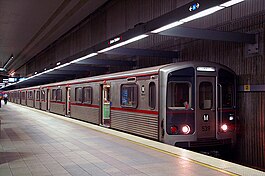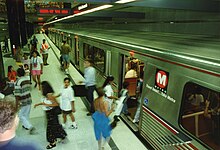B Line (Los Angeles Metro)
| B Line | |
|---|---|
 | |
 B Line train at Union Station | |
| Overview | |
| Owner | Los Angeles County Metropolitan Transportation Authority |
| Termini | North Hollywood Union Station |
| Stations | 14 |
| Service | |
| Type | Rapid transit |
| Train number(s) | 802 |
| Rolling stock | Breda A650 |
| Daily ridership | 72,200 (Weekday, Q3 2022) |
| Ridership | 25,899,711 (2023) |
| History | |
| Commenced | 1993 |
| Completed | 2000 |
The B Line, named the Red Line from 1993–2020, is a rapid transit line part of the Los Angeles Metro Rail system. It opened on January 30, 1993, and was fully completed on June 24, 2000, with 14 stations. The B Line is completely underground, and it has stations in the San Fernando Valley, Central Los Angeles, and Downtown Los Angeles.
The line is one of the two rapid transit lines (along with the D Line) in Los Angeles. The two lines share tracks between Downtown Los Angeles and Koreatown and run for about 20 hours every day. Around 25 million people used the B and D Lines in 2023.[1]
History[change | change source]
Early plans[change | change source]
The B Line (formerly the Red Line) was part of a plan to connect Downtown Los Angeles with a rapid transit line to central and western portions of Los Angeles. Early plans in the 1980s had the line traveling west along Wilshire Boulevard and then north to the San Fernando Valley using Fairfax Avenue. Many people who lived near the proposed line did not like the plan.
In 1985, a methane explosion occurred at a Ross Dress for Less clothing store near Fairfax Avenue. Although the explosion was unrelated to the line, the area became a "methane zone". This stopped any plan for a rapid transit line to travel on Fairfax Avenue.[2]
Due to the explosion, the line changed to travel north on Vermont Avenue instead of Fairfax Avenue. The line would then turn northeast to the San Fernando Valley using Hollywood Boulevard and going under the Santa Monica Mountains. The route on Vermont was originally going to be above ground. It was changed to underground due to complaints from nearby businesses, hospitals, and media studios in Hollywood.[3]

Construction and opening[change | change source]
The project was built in four phases. Construction started on the first phase of the B Line on September 29, 1986.[4] The first phase went from Union Station in Downtown Los Angeles to Westlake/MacArthur Park station. It opened as the Red Line on January 30, 1993.[5] The second phase went from Westlake/MacArthur Park station to Wilshire/Western station in Koreatown. That extension started service in 1996.[6]
The third phase continued to extend the line from Wilshire/Vermont to the Hollywood/Vine station. However, serious problems occurred during the construction of that phase. A sinkhole formed in the ground on Hollywood Boulevard. This nearly hurt many workers and damaged some buildings on the street. This issue stopped construction until experts could safely fix it. The third phase eventually opened in 1999.[7]
The project's fourth phase completed the rapid transit line from Hollywood/Highland to North Hollywood station. It opened on June 24, 2000. This phase required tunneling under the Santa Monica Mountains.[8] Metro had plans to make the line longer, but those plans were stopped. The city of Los Angeles decided not to use more money for building more subway tunnels in 1998. They thought rapid transit lines were too expensive. Instead, those plans were replaced with new light rail lines and busways.[9] Overall, the construction of the current line cost $4.5 billion.[10]
Once the line was complete, trains began running on two routes. Union Station to Wilshire/Western and Union Station to North Hollywood. To clarify, the trains that went to Union Station and Wilshire/Western were renamed, the Purple Line, in 2006.[11] In 2020, the Red Line was renamed to the B Line, and the Purple Line became the D Line. This happened because the Metro decided to use letters instead of colors for all train and bus line names.[12]
Operations[change | change source]

The B Line begins service daily at 4:30 a.m. and ends around midnight. During the day, trains are scheduled to come every 12 minutes. In the early mornings and late nights, trains are scheduled to come every 20 minutes.[13]
The rolling stock (trains) used on the B and D Line are called the Breda A650. Metro operates those trains with six cars during rush hours and four cars at other times. The B Line and D lines operates out of the Division 20 Yard (Santa Fe Yard). This yard also stores and gives maintenance to the trains. The yard is located east of Union Station.
In 2017, Metro bought new rolling stock for the rapid transit lines. One of the new trains is called the CRRC HR4000. They will start operating in 2024 and replace some older Breda A650 trains. The other trains are called Hyundai Rotem HR5000 which will replace the other ones.[14]
Route and stations[change | change source]

The B Line stops at 14 stations from Union Station to North Hollywood. All stations are underground. The line's northern station is North Hollywood station in the San Fernando Valley. Heading towards Union Station, the line turns southeast and passes underneath the Santa Monica Mountains. When it reaches the Hollywood/Highland station, the line travels east underneath Hollywood Boulevard. At the intersection of Vermont and Hollywood, the line turns south under Vermont Avenue until it connects to the D Line's tracks at Wilshire/Vermont Station. B Line shares the same track and 6 stations with the D Line from Wilshire/Vermont to Union Station.[15]
| Stations | Opened | Neighborhood | Connections |
|---|---|---|---|
| North Hollywood | June 24, 2000 | North Hollywood | |
| Universal City/Studio City | Studio City | ||
| Hollywood/Highland | Hollywood | ||
| Hollywood/Vine | June 12, 1999 | ||
| Hollywood/Western | East Hollywood | ||
| Vermont/Sunset | |||
| Vermont/Santa Monica | |||
| Vermont/Beverly | |||
| Wilshire/Vermont | July 13, 1996 | Mid-Wilshire/Koreatown | |
| Westlake/MacArthur Park | January 30, 1993 | Westlake | |
| 7th Street/Metro Center | Downtown Los Angeles | ||
| Pershing Square | |||
| Civic Center/Grand Park | |||
| Union Station |
References[change | change source]
- ↑ "Metro Interactive Estimated Ridership Stats". Los Angeles County Metropolitan Transportation Authority. Retrieved April 21, 2024.
- ↑ Reft, Ryan (January 28, 2015). "Building Subways in the Post World War II World: Los Angeles and Washington D.C." Tropics of Meta. Archived from the original on November 14, 2021. Retrieved November 14, 2021.
- ↑ "Metro Red Line Extension System Planning Study" (PDF). Los Angeles County Metropolitan Transportation Authority. August 1989. p. 11. Retrieved April 21, 2024.
- ↑ "25 Years Ago Today: Los Angeles' Red Line Subway Breaks Ground". Dorothy Peyton Gray Transportation Library and Archive. September 29, 2011. Archived from the original on November 14, 2021. Retrieved November 14, 2021.
- ↑ Katches, Mark (January 31, 1993). "Red Line Rolls to Raves – It's Smooth Railing As L.A. Subway Opens". Los Angeles Daily News.
- ↑ Bloom, David (May 22, 1996). "MTA Unveils New Downtown Line". Los Angeles Daily News.
- ↑ Gordon, Larry; Kennedy, J. Micheal (June 23, 1995). "Street Vanishes in Subway Sinkhole : MTA: Burst water main weakens earth above tunnel, causing half a block of Hollywood Boulevard to collapse". Los Angeles Times. Archived from the original on October 5, 2018. Retrieved October 18, 2018.
- ↑ Sheppard, Harrison (June 18, 2000). "End of the Line". Los Angeles Daily News.
- ↑ "Anti-Subway Funding Measure Wins Easily". Los Angeles Times. November 4, 1998. Archived from the original on October 22, 2020. Retrieved September 15, 2019.
- ↑ Purdum, Todd S. (2000-06-23). "Los Angeles Subway Reaches End of the Line". The New York Times. ISSN 0362-4331. Retrieved 2024-02-14.
- ↑ Hymon, Steve (2018-01-29). "Red/Purple Line subway celebrates 25th anniversary". The Source. Retrieved 2024-03-16.
- ↑ "LA, meet our new lineup". www.metro.net. Retrieved December 23, 2023.
- ↑ "Metro Maps and Schedules". metro.net. December 10, 2023. Retrieved February 12, 2024.
- ↑ "Authorize Request For Proposal Solicitation Of New Heavy Rail Vehicles (HRV)" (PDF). LA Metro. 6 November 2014. Retrieved 10 Feb 2024.
- ↑ Chiland, Elijah. "A guide to the subway formerly known as the Red Line". la.curbed.com. Curbed. Retrieved 9 September 2023.
